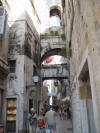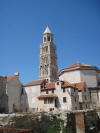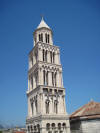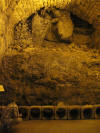Split, Croatia
July 22-24, 2010
There are 24 pictures here.
I arrived in Split July 22, two days
before the swimming adventure started, to recover from jet lag.
Split has the greatest Roman ruins in
Eastern Europe. In the fourth century A.D., The Roman Emperor Diocletian wanted
to retire in his native Dalmatia, so he built a huge palace here. Eventually the
place was abandoned. Then locals, fleeing seventh-century Slavic invaders, moved
in and made themselves at home, and a medieval town sprouted from the rubble of
the old palace. In the 15th century, the Venetians took over the
Dalmatian Coast. They developed and fortified Split, slathering the city with a
new layer of Gothic-Renaissance architecture.
The waterfront
A001  A002
A002  A003
A003 
Along the promenade
A004
 A005
A005
 A006
A006

I saw a lot of attractive young women,
but then when they pulled out a cigarette and started smoking, they became
unattractive to me.
I stayed two nights at the Base Sobe,
recommended by the Rick Steves’ Guide Book. It was right in the center of the
Old Town. The Old Town is the walled part of the city that has been around for
hundreds of years. There was a computer in the room with free internet access.
Here are Tina Saric and her father Ivo, who run the place. They were very nice
to me.
A007

Diocletian’s Palace
is the remains of Roman Emperor Diocletian’s palace, as added to and revised
over the centuries. It was built around 300 A.D. It took 11 years to build
(rapid for those days – more than 2,000 slaves died during construction). He is
best remembered for two questionable legacies: dividing the huge empire among
four emperors (which helped administer it more efficiently, but began a
splintering effect that arguably led to the empire’s decline) and torturing and
executing Christians, including thousands on the Dalmatian Coast.
One reason for the location of the palace
was the medicinal sulfur spring, as Diocletian was in poor health as he got
older.
Here are some scenes. Some of the streets
were very narrow, as is typical in many medieval European towns.
A008
 A009
A009

A010
 A011
A011
 A012
A012

Cathedral of St. Dominus A013
 A014
A014

I
decided not to go up to the top of it. I guess I have done enough of those in my
travels.
However I did go to the top of the
Ethnographic Museum. The stairway consisted of narrow steps going around in a
square spiral several stories high. Here is the view from the top.
A015
 A016
A016

A017
 Here is a detail of one of the
old Roman columns.
Here is a detail of one of the
old Roman columns.
Diocletian’s Cellars,
under the palace, were originally designed to hold water from three sources: a
freshwater spring, a sulfur spring, and the sea. Later medieval residents used
them as a dump, which mostly have been excavated and used for art exhibits and
souvenir stands.
A018
 A019
A019
 Touristy part of the cellar
Touristy part of the cellar
A020
 A021
A021
 A022
A022
 Where the waters were
stored.
Where the waters were
stored.
A023
 Not excavated yet.
Not excavated yet.
A024
 Parts of Roman water pipes.
Parts of Roman water pipes.
Just outside the walls of the Old Town
was a farmer’s market. I was hungry, so I bought a nectarine, washed it at a
nearby spigot, and ate it. It was good.
Here in Split I found gelato ice cream.
It is made differently than in the U.S. and it was soooo good. I started to have
one a day throughout my entire trip.
After two nights in Split, I took a bus
to Šibenik and then a ferry to Prvič
to continue my adventure.
That's all for Split.
